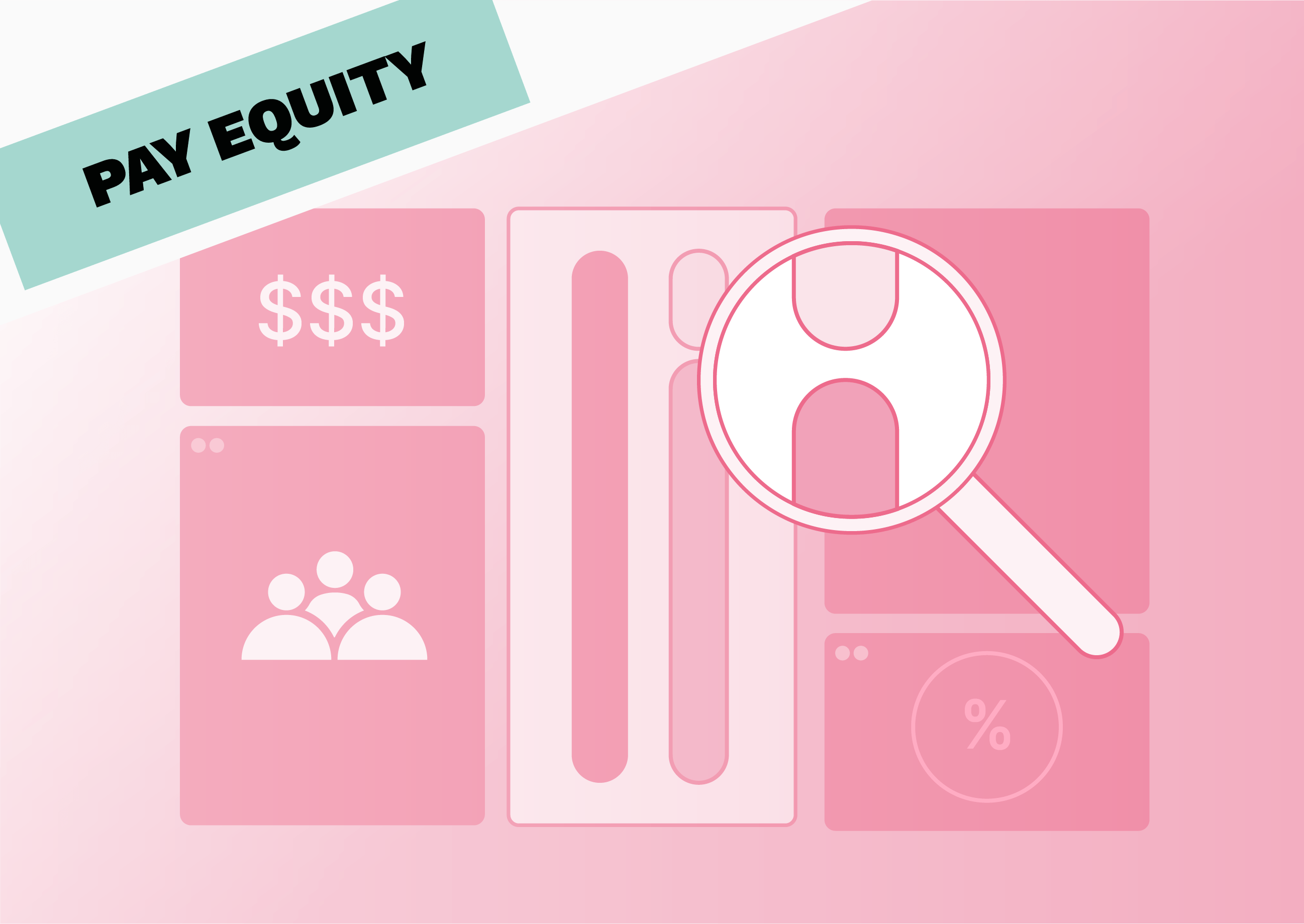Key points:
- Job architecture is the foundation for genuine pay equity: without standardised job levels, you can't meaningfully compare roles or identify unfair pay gaps.
- The EU Pay Transparency Directive requires job architecture to comply: the Directive mandates reporting on workers performing "the same work or work of equal value."
- Clear career paths reduce turnover: job architecture makes progression visible, giving employees concrete targets for advancement.
Less than 50% of organisations say their job architecture meets the needs of their business. That can be worrying when you're managing 200+ employees across different departments, locations, and skill sets.
Without a clear system, compensation becomes a bit of a mess. One developer earns 20% more than their equally skilled colleague simply because they joined during a talent shortage. Your marketing manager's salary hasn't kept pace with market rates because "that's what we've always paid." Sound familiar?
These inconsistencies create pay gaps, demotivate your best performers, and put you at risk when the EU Pay Transparency Directive comes a-knocking in 2026.
That’s why you’re putting in the work now. Because a well-designed job architecture can make your life so much easier. And if that’s not enough for you to sort them out, they can also prevent pay equity issues, which brings its own benefits.
We'll show you exactly what job architecture means, why it matters (especially now), how to build one that works, and which tools make the process manageable. Let’s get started.
What is job architecture?
Job architecture is a structured framework that organises all roles within your company into logical groups and levels. It creates a clear map of how positions relate to each other, what skills they require, and how employees can progress through your organisation.
Granted, that’s the easy definition. Truth is, there’s a little bit more complexity at work, as there are different components that make up your job architecture:
- Job families: Groups of similar roles sharing common skills and purposes. Your Engineering family includes software developers, QA testers, and DevOps specialists.
- Job levels: Distinct stages within each family reflecting increasing scope and impact. Junior roles handle defined tasks with guidance. Mid-level positions manage projects independently. Senior roles drive strategy and mentor others. Lead positions shape department direction and influence company outcomes.
- Job profiles: Clear descriptions for each specific role outlining exact responsibilities and expectations. A Senior Backend Developer profile specifies that they must architect scalable systems, review code, and mentor two junior developers. These profiles remove ambiguity about what success looks like.
- Skills and competencies: The specific abilities required at each role and level. A Junior Data Analyst needs SQL proficiency and Excel skills. A Senior Data Analyst requires Python expertise, statistical modeling, and stakeholder management capabilities.
- Career paths: Defined pathways showing progression opportunities within your company. Employees see exactly how to advance vertically (Junior Developer → Senior Developer → Tech Lead) or move laterally (Product Manager → Marketing Manager). No more guessing about next steps.
💡 Did you know? Companies with well-defined job architecture report 23% lower turnover rates. Employees stay when they understand their growth potential.
What is the difference between job architecture and position management?
Job architecture defines the framework of roles and levels across your organisation. Position management tracks specific headcount and individual employees within those roles.
Here's a more in-depth breakdown:
Job architecture:
- What roles exist in our organisation?
- How do jobs relate to each other?
- What skills progress from junior to senior levels?
- How do we define fair compensation for each level?
Position management:
- How many people work in each role?
- Who reports to whom?
- What's our current headcount budget?
- Which positions are filled versus vacant?
💡 The catch: Most companies try to manage both in spreadsheets, which creates confusion. When your Marketing Manager gets promoted to Senior Marketing Manager, does that create a new job or just fill a new position? Without clear systems, these questions derail compensation planning.
That’s why you build your job architecture first, then use position management to track how people fit within that structure. You’ll thank us in the long run.
Why job architecture is your secret weapon
Think of it like this: it's your organisation's reference system for how work gets done and how people progress. Job architecture isn't just an organisational chart exercise. It's the foundation that makes pay equity possible and compliance achievable.
That’s not even mentioning how crucial standardising your job architecture can be for integration of compensation software. If you’re providing software with a ton of job titles that only make sense to your organisation, you’re going to have a bad time.
It creates a foundation for genuine pay equity
Most of the time, pay gaps don't appear because someone decided to pay women less than men. They often emerge from organisational chaos.
Here’s an example of a possible situation:
Are these three comparable roles? Should they earn similar amounts?
Without job architecture, you can't answer these questions.
Job architecture fixes this by creating clear definitions. It establishes that all three roles are actually Level 3 Marketing positions requiring similar experience and delivering comparable value. Now you can meaningfully assess whether compensation is equitable.
💡 This is why 82% of companies joining Figures discover pay gaps exceeding the 5% threshold that will trigger mandatory EU action in 2026. They weren't actively discriminating. They simply had no structured way to ensure fairness.
It prepares you for the EU Pay Transparency Directive
The EU Pay Transparency Directive requires employers to provide information on pay levels for workers performing "the same work or work of equal value."
Read that phrase again: work of equal value.
So, how do you determine equal value without job architecture? Well, you can't.
Companies scrambling to comply in 2026 will discover they need to build job architecture first, then audit their pay practices. That’s months of work. Rather than replicating your cramming sessions from your uni days, start revising job architecture now while you’ve got the chance!
‼️If you’re in the UK, you don’t have to calculate based on work of the same or equal value. The government requires the mean and median calculations of all men and women working at a company. Calculating this way means you miss out on nuance, so we’d still recommend sorting your job architecture and following suit with the EU.
It boosts employee development and retention
Career development conversations fail when employees can't see the path forward.
Job architecture makes career progression visible. Employees can see what roles exist at the next level, what skills they need to develop, and what compensation range they can expect.
This transparency matters. A lack of career development opportunities is one of the top reasons for employees quitting. You might as well put a conveyor belt near the exit of your office. And rehearse saying ‘is there anything we can do to get you to stay?’.
Getting the terms right: internal equity, competitive pay, and merit pay
Job architecture helps you balance three compensation principles that often pull in different directions.
Here's how they work together:
Okay, but does that mean in practice?
Well, you might pay a strong performer generously (merit), but create internal inequity. You might maintain internal fairness but lose talent to competitors offering higher pay (competitive). You might match market rates but have no system for recognising individual contribution (merit).
It’s a balancing act where you’re juggling at the same time. You’re constantly having to engage with multiple different factors to ensure you’re keeping employees happy, but not hurting your talent acquisition capabilities. It’s a bit of a circus…
Thankfully, job architecture resolves these tensions. It creates structured levels (internal equity), enables meaningful benchmarking (competitive pay), and defines ranges where performance can be rewarded (merit pay).
Now who said you can’t have your cake and eat it?!
How to build your job architecture in 6 steps
Building job architecture sounds daunting. But take the hard hat off, because it doesn’t have to be daunting!
Here's your practical roadmap for creating a framework that works for a company of around 200 employees:
- Establish your objectives: what problem are you solving? Preparing for the EU Pay Transparency Directive? Standardising chaotic job titles? Creating visible career paths? Be specific. "Create standardised job levels so we can conduct meaningful pay equity analysis before June 2026" beats "fix our compensation mess."
- Map your current roles: audit every job title and document what people actually do. Don't rely on outdated job descriptions; this is your time to talk to employees and managers. Expect this to take 2-4 weeks for 200 employees.
- Define job families and levels: group roles into logical families (Marketing, Sales, Engineering) and create 4-6 consistent levels. A Level 3 in Marketing should require similar experience, autonomy, and impact as a Level 3 in Engineering.
- Create clear job profiles: document responsibilities, required skills, and success metrics for each role. Keep profiles concise; no need for novels. Focus on what differentiates this level from the one above and below it. A strong profile answers: What does this role do? What skills are required? How do we measure success?
- Align employees to the new structure: map every employee to their new job family and level. It’s a sensitive topic. Some will feel undervalued, others delighted. Communication matters here. Explain the framework clearly, emphasise fairness, and plan for appeals with clear re-evaluation criteria.
- Connect to compensation and communicate: link your levels to salary bands using reliable market data. Each level needs a minimum, midpoint, and maximum based on what similar roles earn in your markets.
While spreadsheets can help design the structure, connecting it to live market data is tricky. This is where modern compensation platforms like Figures provide a welcome helping hand, allowing you to build data-driven salary bands that are both internally equitable and externally competitive.
‼️Give yourself plenty of time. If your goal is to build for the EU directive, build your architecture ahead of time, as doing it a month before a report is due can lead to mistakes.
An example of job architecture in action
Let's look at SaaSCo, a 220-person software company expanding across Belgium and Germany.
Uh-oh… Their Head of HR discovered wildly inconsistent salaries. A "Software Engineer" in Berlin earned €58,000. Another "Software Engineer" in Paris earned €72,000. Were they the same level? Different skills? Random historical decisions? Who knows? They certainly didn’t.
Product Managers had it worse. Titles ranged from "PM" to "Product Lead" to "Senior Product Specialist" with no clear relationship to actual responsibility or pay. At this point, the HR head lost their head.
That’s until they built a simple job architecture starting with two families:
💡 Quick tip: Start with engineering first. Engineering titles are the most standardised across the tech industry, giving you quick wins. Success with your 30-40 engineering roles builds credibility when you tackle messier departments like Sales or Operations.
So, what’s the outcome? Well, SaaSCo now states objectively that an E3 and a P3 represent similar levels of impact and responsibility. Their salary bands reflect this equivalence. Both levels sit in the €65,000-€80,000 range adjusted for location.
Good on you, SaaSCo. Now if only your name were as good as your standardisation practices…
From blueprint to reality: how Figures brings your job architecture to life
A job architecture is just a document. Its power is only unlocked when it's connected to real data and used in your core HR processes.
Here's where Figures transforms theory into practice:
- Benchmark: Connect your new job levels to 3.5 million compensation data points powered by Mercer. Find out instantly if your pay is competitive for each level.
- Salary bands: Build, manage, and share fair salary bands for every role and level using real-time market data.
- Pay equity: Proactively monitor for pay gaps across your organisation. The dashboard identifies disparities and provides clear recommendations to close them.
- Compensation review: Run smooth, collaborative reviews without spreadsheet chaos. Save your team approximately three weeks of work per cycle.
And if you want to know how we compare to Excel spreadsheets, we’ve got you covered. Take a look at this handy table:
“Job architecture only works when it's connected to accurate compensation data and embedded in your daily processes. That's where most companies struggle – they build the framework but can't operationalise it.”
— Agnès Chauvigny, VP People @ Figures
Achieve equity by design, not by chance
Job architecture isn't optional anymore. It's the foundation for pay equity in both the EU and the UK. It’s also a requirement for compliance with the upcoming EU legislation, and your most powerful tool for retaining talent through visible career progression.
Without it, you're managing compensation by guesswork and hope.
Building the structure is the first step. Bringing it to life with accurate market data and integrated tools is the next step.
Figures helps you do both. Connect your job architecture to credible benchmarks, build fair salary bands, monitor for pay gaps, and run efficient compensation reviews. All-in-one platform built specifically for European companies.
Book a free demo and discover how Figures can help you develop job architecture from theory into practice.
{{ cta }}
Summarize this article with AI
No time to read it all? Get a clear, structured, and actionable summary in one click.






